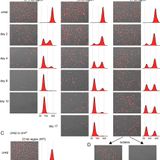RECENT ARTICLES

Establishment of heterochromatin in domain-size-dependent bursts
Edited by Jasper Rine, University of California, Berkeley, CA, and approved March 5, 2021 (received for review November 5, 2020)How repressive heterochromatic states propagate along chromosomes and are subsequently maintained for many cell divisions remain important unanswered questions in biology. Combining mathematical modeling and single-cell measurements, we find that heterochromatin does not propagate in a purely linear manner as often assumed. Rather, sudden transitions can affect large domains globally at once. We suggest this is due to long-range interactions that bring distant...…Edited by Jasper Rine, University of California, Berkeley, CA, and approved March 5, 2021 (received for review November 5, 2020)How repressive heterochromatic states propagate along chromosomes and are subsequently maintained for many cell divisions remain important unanswered questions in biology. Combining mathematical modeling and single-cell measurements, we find that heterochromatin does not propagate in a purely linear manner as often assumed. Rather, sudden transitions can affect large domains globally at once. We suggest this is due to long-range interactions that bring distant...WW…

A pebble accretion model for the formation of the terrestrial planets in the Solar System
Pebbles of millimeter sizes are abundant in protoplanetary discs around young stars. Chondrules inside primitive meteorites—formed by melting of dust aggregate pebbles or in impacts between planetesimals—have similar sizes. The role of pebble accretion for terrestrial planet formation is nevertheless unclear. Here, we present a model where inward-drifting pebbles feed the growth of terrestrial planets. The masses and orbits of Venus, Earth, Theia (which later collided with Earth to form the Moon), and Mars are all consistent with pebble accretion onto protoplanets that formed around Mars’...…Pebbles of millimeter sizes are abundant in protoplanetary discs around young stars. Chondrules inside primitive meteorites—formed by melting of dust aggregate pebbles or in impacts between planetesimals—have similar sizes. The role of pebble accretion for terrestrial planet formation is nevertheless unclear. Here, we present a model where inward-drifting pebbles feed the growth of terrestrial planets. The masses and orbits of Venus, Earth, Theia (which later collided with Earth to form the Moon), and Mars are all consistent with pebble accretion onto protoplanets that formed around Mars’...WW…
- Total 2 items
- 1